The functional development of a premature baby – case study
DOI:
https://doi.org/10.2478/pielxxiw-2020-0015Keywords:
premature baby, functional development, digital technologyAbstract
THE FUNCTIONAL DEVELOPMENT OF A PREMATURE BABY – CASE STUDY
Introduction. The intensive development of modern methods of treatment in neonatology has signifi cantly reduced the survival threshold of prematurely born children. Early interruption of the maturation process of all systems in utero is associated with the risk of irregularities in the functional development of premature babies. Prematurely born children are exposed in the following years of life to many problems related to motor, cognitive, social and communication development, which is why there is a growing demand for more accurate tracking and research into their development. The impact of screen devices on the development of infants and young children is a growing social problem. Currently, thanks to the development of new digital technologies, small children and even infants are growing up in a screen environment.
Aim. The aim of the study was to assess the functional development of a 28 months old child born in 29 weeks of gestation, taking into consideration the multifaceted involvement and effort of parents.
References
1. Chawanpaiboon S, Vogel JP, Moller AB. Global, regional, and national estimates of levels of preterm birth in 2014: a systematic review and modelling analysis. Lancet Glob Health. 2019; 7(1): e37–e46.
2. Czerwińska E. Czynniki wpływające na poród przedwczesny. Ginekologia i Perinatologia Praktyczna. 2018; 3(2): 52–57.
3. Świetliński J. Noworodek urodzony przedwcześnie – wcześniak [w:] Świetliński J. Neonatologia i opieka nad noworodkiem. Warszawa: PZWL; 2018, s.144-155.
4. Rutkowska M, Polak K, Seroczyńska M, i wsp. Długofalowa ocena rozwoju noworodków przedwcześnie urodzonych: doświadczenia własne (badanie PREMATURITAS) na tle wybranych badań europejskich. Perinatologia, Neonatologia i Ginekologia. 2010; 3(3): 175-180.
5. Vandormael C, Schoenhals L, Hüppi PS, et al. Language in Preterm Born Children: Atypical Development and Effects of Early Interventions on Neuroplasticity. Neural Plasticity. 2019: 1-10.
6. Wojtasik Ł, Dziemidowicz E. Urządzenia ekranowe w rękach dzieci w wieku 0-6 lat – zagrożenia, szanse, postulaty profilaktyczne. Dziecko Krzywdzone. Teoria, badania, praktyka. 2019; 18(2):106-119.
7. Bąk A. Jak małe dzieci korzystają z urządzeń mobilnych? Raport na podstawie danych zebranych od rodziców, Dziecko krzywdzone. Teoria, badania, praktyka. 2015; 14(3): 55-82.
8. Radesky J, Dimitri Ch. Media and young minds. Pediatrics. 2016; 138(5): 1-6.
9. Pempek TA, Kirkorian HL, Anderson DR. The effects of background television on the quantity and quality of child-directed speech by parents. Journal of Children and Media. 2014; 8(3):211-222.
10. Spittle A, Orton J, AndersonxPJ, et al. Early developmental intervention programmes provided post hospital discharge to prevent motor and cognitive impairment in preterm infants, Cochrane Database Syst Rev. 2015;11: 1-83.
Downloads
Published
Issue
Section
License
Copyright (c) 2020 Authors

This work is licensed under a Creative Commons Attribution-NonCommercial-NoDerivatives 3.0 Unported License.




